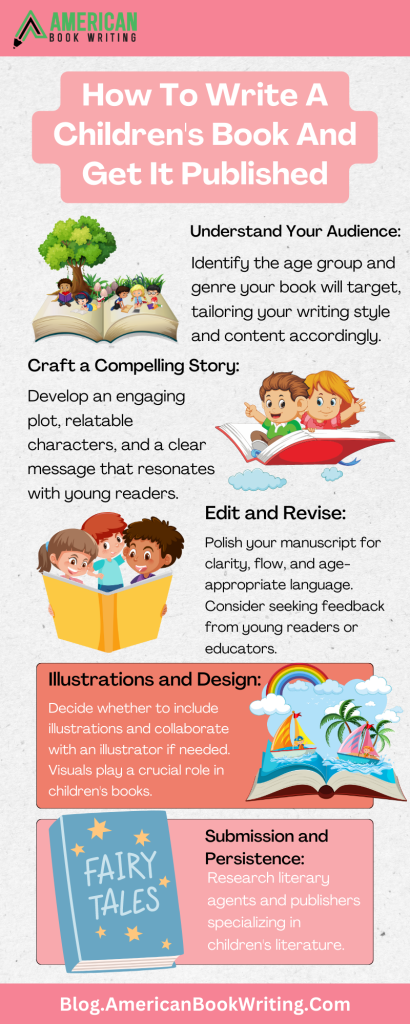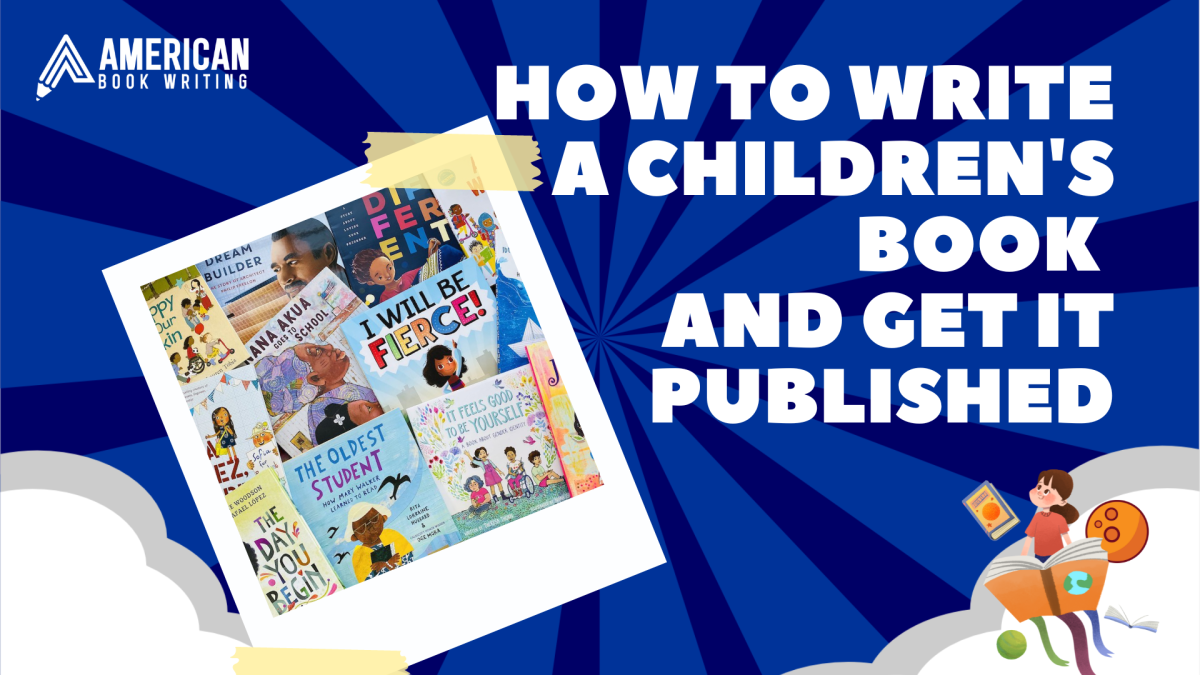Children Book
Press The Play Button On The Audio To Listen Complete Article!
If you have a fantastic story idea to write a children’s book and want to share it with the world, then you are in luck! In this guide, we will be telling you all you need about how to write and publish a children’s book and publish it.
Although it is quite hard to do so, if you follow the steps mentioned below, publishing a book will not be a big deal for you.
1. Writing Your Children’s Book
Before planning and writing your children’s book, you must know exactly who you are writing for. Yes, children in general, but having a specific child in mind is even better.
So, to understand what you want to write, answer the following questions yourself. These questions will help you to figure out what book you want to write and how to write it.
- Is your book for a little boy or girl?
- What age group are they in?
- How much free time do they usually have?
- Are they outgoing or shy?
Take the time to understand your target audience before you begin writing. And as you write, always keep your audience in mind.
You can also create a mood board on Pinterest to keep your dedicated audience in mind and see what you can do to write a children’s book.
Pin images of individuals who resemble your target reader, print out the pictures and keep them at your desk. This will remove any uncertainty about writing for a broad audience and allow you to focus on the exact person reading your book.
Remember, depending on the age of your readers; your book may be read to them instead of by them. This means you can use more advanced language since an adult or older child will likely be reading aloud.
However, it’s still important for your young audience to understand what is being read. Occasionally introducing new words they can ask about and learn from can be helpful, but use them sparingly.
1. Know Your Target Audience
Yes, you need to know your target audience when writing a book, but it’s even more important in publishing too.
If you write a picture book for 2-5-year-olds but market it to infants, you will not be successful. Kids like to read about characters their age or a few years older.
Do some research to find out what different target audiences expect. This includes:
- What themes and keywords are trending
- Who is publishing these sorts of books
- Which authors are most popular with your target audience
When looking for an editor or an agent, demonstrate that you understand your book’s target audience. This shows that you know the business and are a serious author.
Here are the age ranges of children’s books:
- Board books: They are for children ages 0 to 3, with few text and images on each page
- picture books are for children ages 2 to 5 and include no more than 1,000 words per page with illustrations.
- Chapter books: they are for 6 to 10-year-olds, having 2,000 to 30,000 words.
- Middle Grade (MG): 8-12 years old, 30,000 to 50,000 words
- Young Adult (YA): 12-18 years old, 40,000 to 100,000 words
If you are not sure how to write a children’s book, you can also ebook writers for hire to help you. Many talented writers can help you bring your story to life.
2. Edit your manuscript
When you write a children’s book, it’s important to know who you’re writing for. The age group of your target audience will affect the length, complexity, and content of your book.
For example, a picture book for toddlers will be very different from a chapter book for middle-grade readers. Picture books typically have fewer words and simpler sentences, while chapter books can have longer chapters and more complex plots.
Once you know who you’re writing for, you can tailor your book to their needs. This includes choosing the right vocabulary, sentence structure, and plot.
If you’re not confident in your writing skills, you can hire a book writing services to help you. Many companies offer editing and proofreading services specifically for children’s books.
With some planning and effort, you can write a children’s book that your target audience will love.
3. Get Feedback from Readers
Well, one very important thing to do after you write a children’s book and edit it is to get feedback from others. Have an idea about how other people like your book because they will be the ones reading it, so they must like it for that!
If you can get someone in the publishing business to take a quick peek, great, but otherwise, you’re looking for typical buyers who have kids the right age to read it to and gauge their reactions.
You can also ask some kids you may know (kids of your friends or family etc.). Kids can be honest beta readers, and their parents can tell you if your book is appropriate for the market. You can also get feedback from online children’s book communities, including Native American authors.
Here are some tips for getting feedback on your children’s book:
- Ask kids in your family or neighborhood to read your manuscript.
- Ask parents of kids you know to read your manuscript and give you feedback.
- Join online children’s book communities and ask for feedback from other authors and parents.
Getting feedback on your children’s book is important, regardless of your target audience. It can help you ensure your book is well-written, engaging, and appropriate for your readers.
4. Get Illustrations for Your Children’s Book
When you write a children’s book, you need to find an illustrator who can bring your story to life. The right illustrator will understand your vision and create images that will capture the hearts of young readers.
One way to find an illustrator is to look at books that are similar to yours. See what styles of illustration you like and who the illustrators are. You can also search online for children’s book illustrators or find directories of illustrators.
Once you’ve found a few illustrators you’re interested in, look at their portfolios. Pay attention to the style of their work, the types of stories they illustrate, and their overall quality.
When you’re ready to contact an illustrator, send them a copy of your book proposal. This will give them a better understanding of your story and the type of illustrations you’re looking for.
The book proposal should include the following:
- A brief synopsis of your story
- A description of the characters
- The setting of your story
- The tone and mood of your story
- The target audience for your book
- Your vision for the illustrations
5. Query children’s book literary agents
If you want to write a children’s book, you need to find a literary agent. A literary agent is a professional who will help you get your book published by a publisher.
Most publishers don’t accept unagented manuscripts. This means that if you want your book to be considered by a publisher, you need an agent to represent you.
Research your agent:
There are a lot of literary agents out there, so it’s important to do your research and find one who is a good fit for your book.
Here are a few things to look for when choosing an agent:
- The agent should have experience with children’s books. Not all literary agents handle children’s books, so you need to make sure that you find one who does.
- The agent should be passionate about your book. When you query an agent, you should send them a summary of your book and why you think it would fit their list well if the agent seems excited about it.
- The agent should be professional and responsive. When you’re working with an agent, you need to be able to trust them to get things done. Ensure that the agent you choose has a good reputation and is known for being responsive to their clients.
Once you’ve found a few agents who you think might be a good fit, it’s time to send them a query letter. A query letter is a short document that introduces you and your book to the agent. It should include the following information:
- Your name and contact information.
- The title of your book.
- A summary of your book.
- Why would your book be a good fit for the agent’s list?
- Your bio.
6. Submit your story to publishers.
If you want to write a children’s book, you can publish it traditionally or self-publish it.
Traditional publishing is when you find a publisher who agrees to publish your book. The publisher will take care of all the marketing and distribution of your book, and they will pay you a royalty for each sold book.
To publish your children’s book traditionally, you must find an agent, as discussed above. Once you have an agent, they will submit your book to publishers. If a publisher is interested in your book, they will ask you to send them a full manuscript. And if they like your manuscript, they will make you an offer.
If you accept the offer, the publisher will publish your book.
Whereas, Self-publishing is when you publish your book yourself. This means you will be responsible for all book publishing aspects, including editing, formatting, marketing, and distribution.
There are many different ways to self-publish a children’s book. You can use a self-publishing platform like Amazon’s Kindle Direct Publishing or hire a self-publishing service.
Self-publishing can be a great way to retain creative control over your book and to get your book published quickly. However, it can also be a lot of work. You will need to be prepared to do a lot of marketing and promotion if you want your book to be successful.
The best publishing route for you will depend on your circumstances and goals. If you are a first-time author, traditional publishing may be your best option. However, if you are willing to work, self-publishing can be a great way to get your book published.

Pre-Launch Basics
If you want to write a children’s book, it is important to think about how you will market your book. One way to do this is to build a platform. A platform is a group of people who are interested in your words. You can build a platform by writing blog posts, giving talks, or creating content on social media.
Once you have a platform, you can promote your children’s book. For example, you can share links to your book on social media or write blog posts about your book. You can also give talks about your book at schools or libraries.
If you are a teacher, you can use your classroom as a platform to promote your children’s books. You can read your book aloud to your students or have them write reviews of your book. You can also use your classroom to host book signings or author visits.
If you are a parent, you can use your parenting blog or social media presence to promote your children’s book. You can share stories about how your children enjoy your book, or you can give parenting tips that are inspired by your book.
No matter how you build your platform, the most important thing is consistency. The more you share your work with others, the more people will learn about your children’s book and the more likely they will buy it.
Conclusion:
Writing a children’s book is a wonderful and exciting journey that requires passion, creativity, and never giving up. To create a great book, you need to find inspiration, make interesting characters, build an exciting story, and make your writing the best it can be.
Once your book is ready, you can try publishing it so that many children can enjoy your story. Remember, the most important thing is the joy of sharing your imagination with young readers. Keep going, believe in yourself, and enjoy the magic of writing children’s books!




